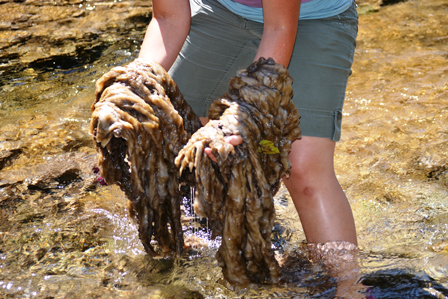 |
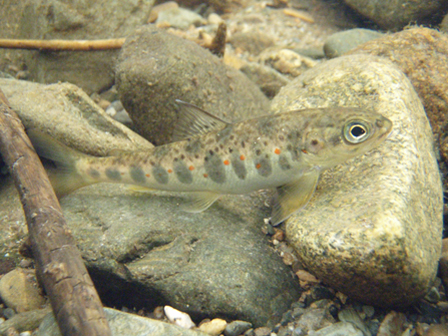 |
 |
|
Didymo bloom. In 2013,
the Duval River
(tributary of the renowned Bonaventure River) experienced the most
severe didymo bloom ever recorded in eastern Canada and comparable to
extreme blooms observed over the past decade in New Zealand. In eastern Canada, recent
climate warming may play a role in the establishment of conditions that favor didymo
proliferation. Other Canadian provinces where didymo blooms have been
identified as a concern include British Columbia and Alberta. Photo Credit: Michel Chouinard |
Juvenile Atlantic salmon. Because of
habitat overlap, didymo blooms pose an additional threat to
vulnerable salmon populations and may reflect changing freshwater
environments in these iconic river ecosystems of Quebec and New
Brunswick. Blooms are known to impact the invertebrate prey and
feeding behavior of the juvenile salmon. That said, researchers
still have a relatively poor understanding of the direct impacts of didymo blooms on juvenile salmon and their habitat. Photo credit: Jonna
Karhunen |
Underwater perspective of a bloom.
A didymo mat several centimeters thick covers the rocky substrate of the
crystal clear Duval River. Thick and extensive blooms are known to
affect the structure and function of river ecosystems. Didymo’s recent
proliferation is likely unprecedented in eastern Canada and elsewhere
around the world. Photo Credit: Carole-Anne Gillis |
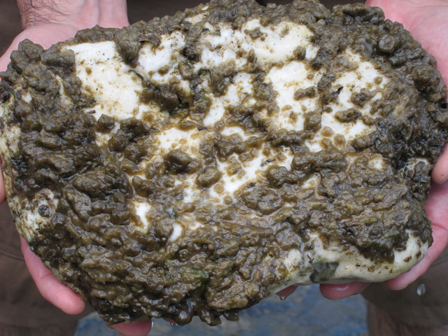 |
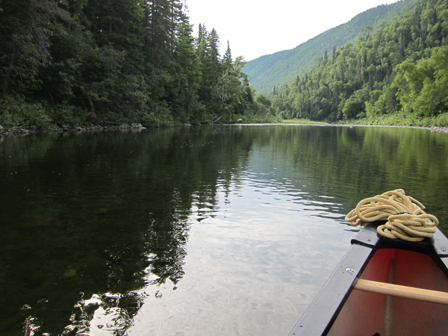 |
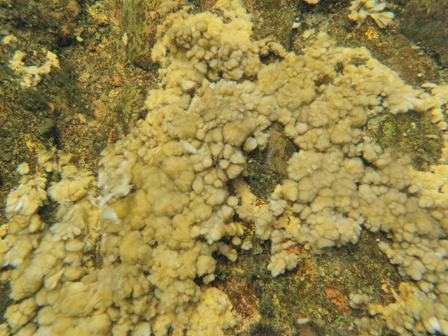 |
|
Didymo on rock. Although the
distribution of didymo within a river ecosystem can be patchy, sections
of river many kilometers in length can be almost entirely covered by
didymo if conditions are favorable. Here is an example of didymo growth from the Patapedia River. In this particular stretch of
river, for several kilometers, the percent coverage of didymo was >75%.
Photo Credit: Michelle Lavery |
Patapedia River algal survey. In
August 2012, Queen’s University researchers visited several rivers in
the Restigouche River watershed to conduct biomonitoring surveys to
better
understand the ecological distributions of didymo and other riverine diatom
species. Photo Credit: Michelle Lavery
|
Didymo on rock. A growth
of didymo covers the surface of a rock from the Upsalquitch River.
Didymo has the texture of wet cotton and is sometimes referred to as
“rock snot”. Photo Credit: Michelle Lavery |
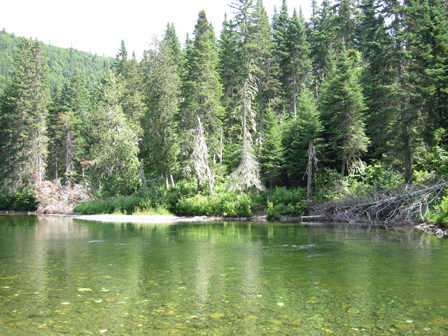 |
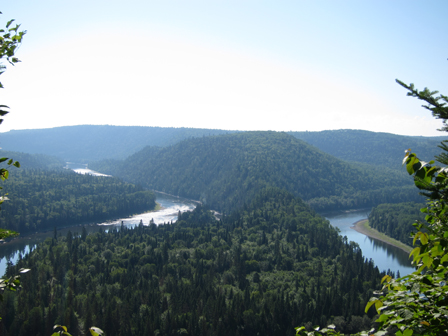 |
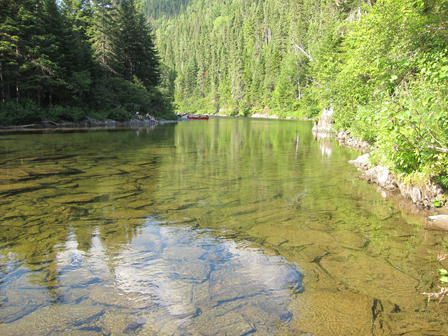 |
|
Patapedia River. Rivers in
the Restigouche River watershed are noted for their excellent water quality
and these ecosystems are considered relatively pristine. Didymo presents
an interesting paradox in that blooms tend to occur when dissolved
nutrients are low. Typically, algal blooms develop when excess nutrients
enter a lake or river. This is known as cultural eutrophication and in
extreme instances causes severe ecological damage.
Likely, several factors are favouring didymo proliferation in eastern
Canada, including climate warming. Photo Credit: Joshua Kurek |
Restigouche River view. This
region of Quebec and New Brunswick is noted for its remoteness,
relatively minimal human impacts (aside from forestry operations), and
a large number of world-class Atlantic salmon fishing opportunities.
Renowned rivers in this region that are experiencing recent didymo blooms
include the Restigouche, Matapedia, Bonaventure, and Cascapedia. Photo
Credit: Joshua Kurek |
Salmon pool. A salmon holding
pool on the Patapedia River. Note the coverage of didymo on the rocks in
the foreground. Photo Credit: Michelle Lavery
|
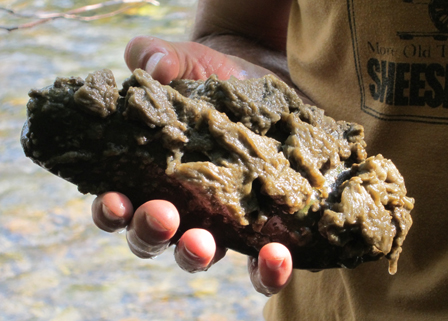 |
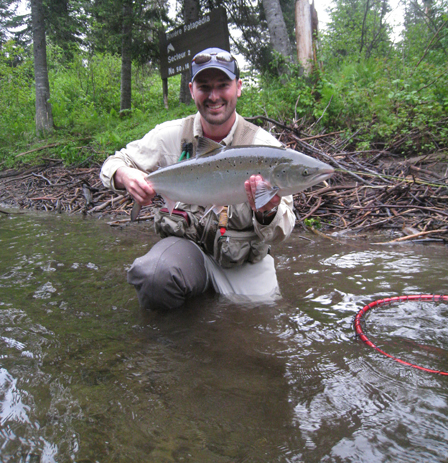 |
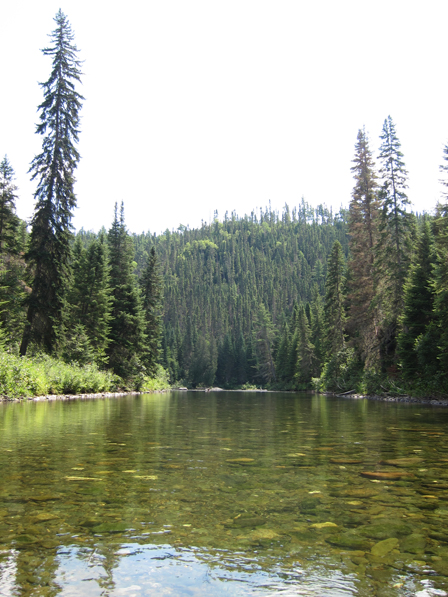 |
|
Didymo on rock. Didymo blooms
several centimeters thick have been observed on the Upsalquitch River in
New Brunswick. After a large rainfall event in 2013, the salmon barrier
on the northwest Upsalquitch River became clogged with didymo that had
been released from the substrate because of high waterflow. Photo
Credit: Michelle Lavery |
Atlantic salmon angler.
A New Brunswick angler practicing catch-and-release of a salmon from the Patapedia
River.
Recreational angling
for wild Atlantic salmon is important to the economy of eastern Canada
and economic benefits were estimated at $255 million in 2010. Anglers
often complain of clumps of didymo fouling their fishing lines and the
unsightly nature of extreme blooms. Photo credit:
Nick Levandier |
Patapedia River. The Patapedia
River is remote and fishing is restricted to only a handful of permitted
anglers each day. At access points, anglers are advised to wash their
equipment in order to reduce the chance of didymo (and other
aquatic species) spreading to new ecosystems. Didymo can live for days in damp
fishing gear and several states in the US have instituted bans of
felt-soled wading boots. However, changing river conditions may be an
important factor to consider with respect to recent didymo blooms. Photo
Credit: Joshua Kurek |
|
